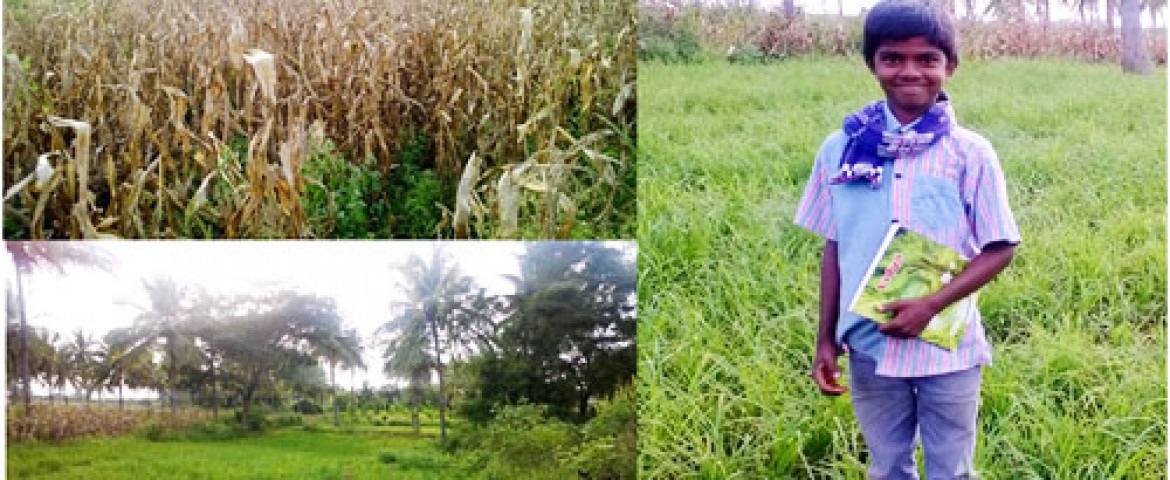|
In the past, MYRADA has focused on improving the efficiency of credit Delivery systems, trying to make them more responsive to the needs of the poor. Our efforts were directed towards trying to persuade and pressurise banks and cooperative societies to advance credit to the poorer sections of the rural population, and to do so in time. To facilitate this transfer we often made deposits in these banks and cooperative societies, which worked as incentives or as risk and collateral coverage. As far as cooperative societies were concerned, our efforts also included increasing the membership to cover more numbers of poor families and motivating the Management to increase the representation of the poorer people on their Boards. Training was given to Society staff; in addition, often infrastructure like godowns and offices were also provided. The constant contact that MYRADA staff maintained with these financial institutions helped to move resources, though the issue of timely credit with regard to agriculture continued to be a problem and often MYRADA advanced loans that were later reimbursed. Similarly, MYRADA also assisted the staff of these institutions in making recoveries, often providing vehicles and accompanying the bank and cooperatives’ staff to the villages to make recoveries in kind. Thus `extension’ for credit and related services was encouraged to penetrate further into the rural areas.
However, in many cases the solutions were not permanent and in some cases they did not address the problem at all. The issue of timely agricultural credit continued to pose a problem; MYRADA could not hope to cover all needy farmers with direct advances and further, what would happen when we pulled out of the area? Secondly, banks advanced credit to the poorer farmers for programmes that they determined were viable irrespective of whether the borrower felt that way or not. The calculation of viability frequently failed to take into account the preferences, resources and skills of the family taking the loan. Some schemes were predetermined and could not be modified or changed to meet the real needs of the borrower. Small, short duration loans for business activities were not forthcoming. On the whole, others made decisions for the people even when they received the money. The patronage system continued. Thirdly, it was absolutely out of the question to approach the bank for small loans to meet urgent consumption loans like a sickness in the family. These and other such problems (bureaucratic procedures being the last but not the least of them), continued to distance the poorer people from the formal credit institutions and accounted for the continued relevance and popularity of the moneylender in every village.
If commercial banks were governed by policies that were formulated at the national level over which individual bank branches operating in remote villages had no control, the cooperative society was certainly envisaged to be a different kind of an institution. It was a concept born out of optimism and faith in human nature. It was conceived of as the most representative form of people’s organisation. It was an institution owned and governed by its members. It was highly localised. Its by-laws could be framed to permit a wide range of activities to be taken up to meet the specific needs of its members. With Government support it was possible for the Society to control and administer fairly sizeable resources with which to meet the needs of members. It could engage in business activities and earn profits that were exempted from taxation. It could distribute these profits among members as an incentive to cooperate more and benefit further. Its management could be changed by members whenever it posed a threat to efficiency; its by-laws could be changed by members whenever they felt their needs had changed. Conceptually, the cooperative society could not be faulted. Yet, almost all the societies that we came in contact with in our project areas were either defunct, or on the verge of becoming defunct, or kept alive with artificial props.
The money lenders were exploitative because they were motivated by personal gain; the banks had limitations on account of structure and policy. But what accounted for the failure of the cooperative society?
From our long and close association with cooperative societies we were able to isolate some factors which we felt had contributed to the present situation.
-
Cooperative Societies were made up of socio-economically heterogeneous groups of people. Big farmers and landless labourers could both be members of the same society. Not surprisingly, the socio-economic relationships that existed between members in their day-to-day lives were carried over into society meetings also. The needs of a casual labourer are different from the needs of a big farmer. But under conditions of inequality, the poor often have to give in to the powerful. The economic barrier and the caste barrier were too strong for all the people to function together as a composite unit. The society was not “socially viable”; it was not homogeneous.
-
Cooperative Societies had a membership that was too large for effective communication. Meetings were attended only by a fraction of the members; discussions were limited to a further fraction of those who attended. Most people were not even aware of what it meant to be a member of a cooperative.
-
On account of the large size decision making was delegated to a small group of members; they represented the other members. This group became even more powerful and often took decisions favourable only to itself, ignoring the needs of the vast majority. Further, representation of poorer farmers on the Board did not automatically ensure that they participated effectively at meetings to see that benefits actually reached the poor.
-
Some of the rules of the Government also worked against the poor. Fresh lending,for example, was only possible if 40% of the loans of the society as a whole came back. Rich farmers with large loans defaulted because to them it did not matter whether they got another loan next year or not. Poor farmers, with good repayment records, dependent on the society for loans each year, suffered because of curbs on lending on account of the high rate of non- recoverable loans of the big farmers.
-
The Cooperative Movement, though conceived of as a means to support the rural people, was a movement that did not emerge from the people. It was a movement that was State sponsored and State supervised and hence, the majority of the people could not relate with it. It created an impression that it was an extension of the Government and the people did not feel any sense of responsibility towards it. Further, the societies were bound by rules so rigid that it killed all flexibility and voluntarism.
-
Last but not the least, cooperatives were controlled and exploited by politicians who used them as stepping stones to power.
These, we felt were major contributory causes to the breakdown of cooperative societies.
Mention must also be made here of the Village Development Associations(VDAs) organised by MYRADA from around 1982 onwards in the different villages of our projects, through which developmental programmes were channelled. Apart from others functions VDAs also took the responsibility for monitoring inputs and recoveries on credit issued by the financial institutions through MYRADA’s initiatives. They consisted of members from all strata of the village society. The VDAs were effective for delivering and monitoring a package of programmes chalked out by MYRADA, the banks and the cooperatives, but they did not provide a system and a culture to allow the people to meet as equals, encourage local initiatives, manage credit and build up a common fund and a programme in which they all had a stake. Over a period of time it was seen that these VDAs too were not an effective instrument of development mainly because of the heterogenous membership and the delegation of decision making to a small committee usually drawn from the upper caste and class. MYRADA’s presence, while preventing the rich from receiving any benefits, did not stop them from taking the credit for providing resources to the poor. The patronage relationship between the rich and the poor was thus strengthened. Further, there was no opportunity for the weaker members to build up their skills and resources and gain controlover their own lives.
IN SEARCH OF ALTERNATIVES : CREDIT MANAGEMENT GROUPS
While making an earnest search for alternatives we noticed that there were a few small groups of women organised by one of our women staff who had been encouraged to make weekly savings of whatever small amounts of money they could put aside. Of their own accord they had made some rules to discourage withdrawals until their accounts had reached a certain size. However, sometimes there were occasions when one of the group members needed money urgently and needed a slightly bigger amount than what she had managed to save. Since there was money available in the group the other group members saw no harm in making advances out of the fund after they had checked out the genuineness of the need and agreed upon a rate of interest, mode of repayment and time frame for repayment. Why should a fellow member approach a moneylender when her own group had the means to support her? In the bargain, not only would her need be met without her being caught up in the cycle of indebtedness, her group too could expand its resource base with the interest earned.
We felt we were on the verge of an answer. When the large Cooperative Society on our Project at Kadiri broke up of its own accord into 14 small groups our ProjectOfficer tried his best to bring them together again but realised the futility of it when they explained to him that they distrusted the leadership and that in any case, their needs and interests were too varied for them to be adequately considered and met through the Cooperative. They preferred to meet as small independent groups with members sharing common concerns and a feeling that they could trust and work with one another. There was merit in this argument. That year, when the agricultural season came, instead of approaching the Cooperative for crop loans the groups approached the MYRADA Project Office for working capital support. They had had many meetings to calculate what their requirements were, how they would use the money, and when and how they would repay it before they approached MYRADA with their request. The staff were initially uncertain but finally decided to take the risk and advance them the money because the agricultural season was upon them, the moneylender was the only other option, and because they felt that the group deserved this chance. What they then noticed was that not only was the money managed more carefully there was also a far greater responsibility and commitment from the group as a whole towards repaying this amount, something that had never unduly bothered the people when they were dealing with the Cooperative. Significantly, on this occasion there was little pressure on the staff to help with decisions and chase people for recoveries.
In studying these groups MYRADA isolated some features common to all of them that could explain why they were more efficient and responsible.
The new groups were small, homogeneous with regard to concerns, needs, and interests, fully participative (i.e. since decisions would affect all of them, they all participated in decision making, instead of delegating it to a committee), voluntary and non-political. In some places the members belonged to different castes, in others they were all from the same caste; some included both men and women, others just the one or the other; in somecases all members practiced the same occupation, in others they differed but were of the same economic status. But they all had the features mentioned above.
|







